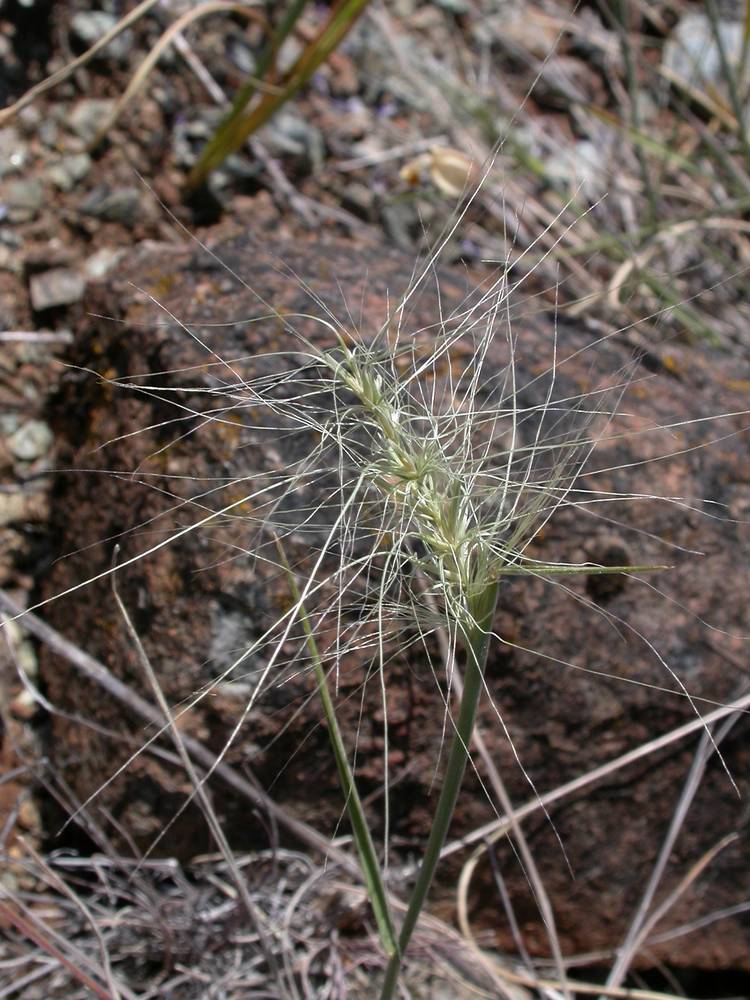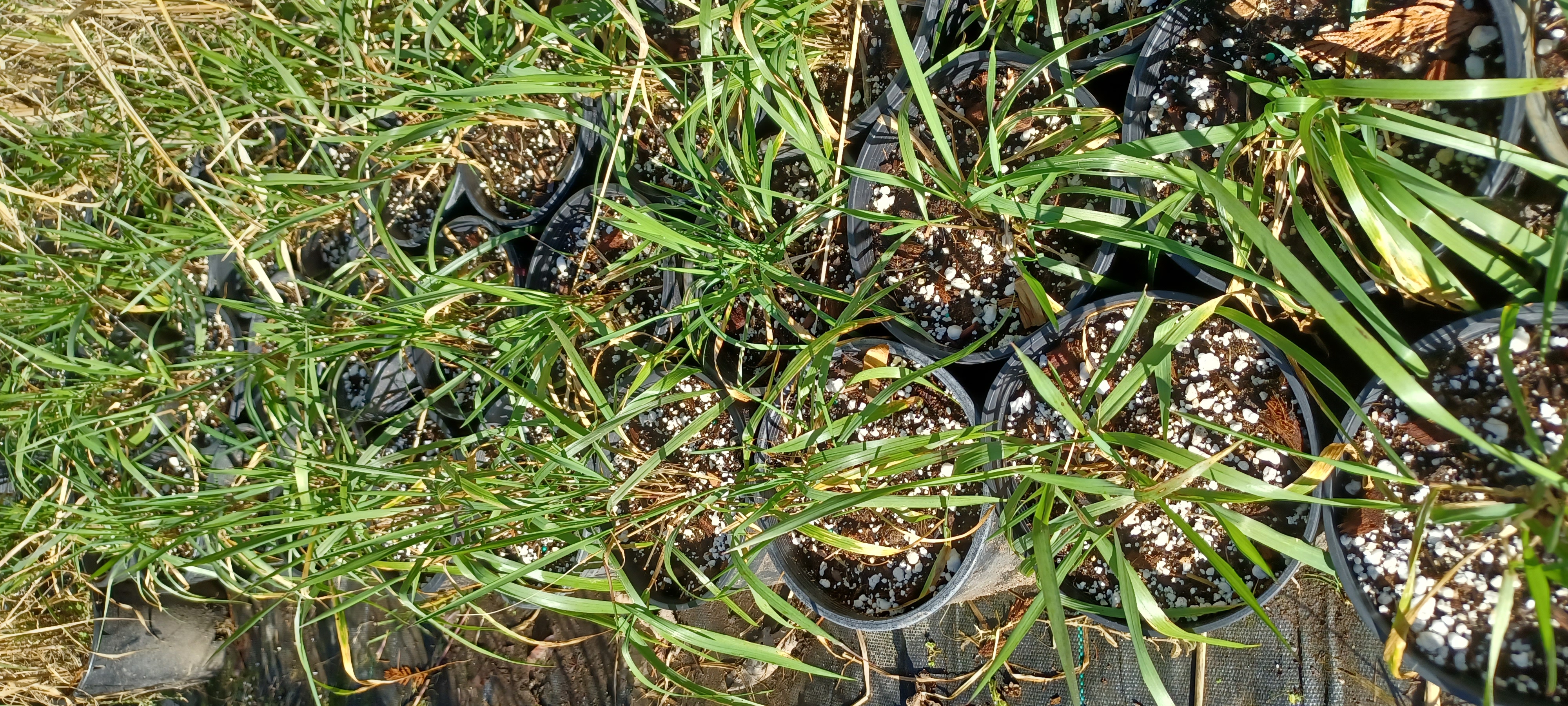Elymus multisetus
Elymus glaucus
big squirreltail
blue wildrye
erect to ascending.
erect or slightly decumbent.
sheaths glabrous or white-villous;
blades 1.5–4 mm wide;
upper surfaces scabrous or hairy.
sheaths glabrous, scabrous, or short- to long-hairy, those of the lower leaves often purplish;
blades 2–13(17)mm wide, usually lax and flat or sometimes involute;
upper surfaces glabrous, scabrous or with appressed hairs on the veins, sometimes with longer often spreading hairs.
5–20 cm; erect, sometimes partially enclosed in the sheath of the uppermost leaf, 2 spikelets per node or rarely 3–4 at some nodes;
internodes 3–5(8)mm;
disarticulation initially at the rachis nodes; later beneath each floret.
5–21 cm, usually erect, 2 spikelets per node or rarely 1 or 3;
internodes 4–8(12)mm;
disarticulation above the glumes and below each floret or rarely also below the glumes.
10–15 mm, divergent, 2–4 florets; lowest florets sterile and glume-like in 1 or both spikelets at each node.
8–25 mm, appressed to slightly divergent; (1)2–4(6) florets.
(10)30–100 mm including the awns; the bases hard and glabrous;
glume bodies about (2)5–10 × 1–2 mm, setaceous, 2–3-veined;
margins firm;
glume awns (8)25–90 mm; each split above the base into 3–9 unequal divisions, scabrous, flexuous to outcurving from near the bases at maturity.
75% as long as or equaling the adjacent lemmas, bases often overlapping, usually flat and thin with evident veins;
glume bodies (5)9–14(19) × 0.5–2 mm, linear-lanceolate; entire, widening above the base; (1)3–5(7)-veined, 2–3 veins extending to the tips, glabrous;
veins smooth or evenly scabrous;
margins 0.1–0.2 mm wide; whitish hyaline, tapering toward the tips;
glume awns 0–5(9) mm; straight.
fertile lemmas 8–10 mm; smooth or scabrous near the tips, 2 lateral veins extending into bristles to 10 mm;
lemma awns (10)20– 110 × 0.2 mm at the base, divergent to arching.
(8)9–14(16) mm, glabrous, scabrous, or short-hirsute;
lemma awns; if present; (0)1–30(35)mm, usually straight to flexuous, sometimes slightly curving.
1–2 mm.
1.5–3.5 mm.
=28.
=28.
Elymus multisetus
Elymus glaucus
Dry, often rocky grasslands and savannas. 50–2000m. BR, Col, ECas, Lava, Sisk, WV. CA, ID, NV, WA; southeast to CO, south to Mexico. Native.
Elymus multisetus has inflorescences that fall apart at maturity and glumes that are divided into three to nine widely spreading awns. Very similar E. elymoides has glumes that are entire or unevenly split into two to three parts. Determining how much the glumes are split is complicated by the presence of glumelike sterile lemmas in both E. multisetus and some E. elymoides subspecies. Elymus multisetus glumes are divided above the base. If the glumes appear to be divided to the base, the plant is more likely to be E. elymoides.
3 subspecies; 2 subspecies treated in Flora.
Rare E. glaucus individuals with a single spikelet at each node can be confused with E. trachycaulus, which usually has shorter anthers, less tapered glumes that often lack awns, and stiffer, narrower leaves that are more basally concentrated. Elymus glaucus hybridizes with E. elymoides, E. multisetus, and E. trachycaulus, as well as species of Leymus and Hordeum. The intrageneric hybrids are often fertile.
Barbara Wilson, Richard Brainerd, Nick Otting
Barbara Wilson, Richard Brainerd, Nick Otting
- Local floras:
CA,
OR,
WA
- Local Web sites:
CalFlora,
CalPhotos,
Flora NW,
PNW Herbaria
WildflowerSearch
iNaturalist (observations)
USDA Plants Database
- LBJ Wildflower Center
- SEINet
- Plants of the World Online
- Encyclopedia of Life
- Wikipedia
- Google Image Search
- Local floras:
BC,
CA,
OR,
WA
- Local Web sites:
CalFlora,
CalPhotos,
Flora NW,
PNW Herbaria
WildflowerSearch
iNaturalist (observations)
USDA Plants Database
- LBJ Wildflower Center
- SEINet
- Plants of the World Online
- Encyclopedia of Life
- Wikipedia
- Google Image Search





